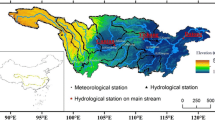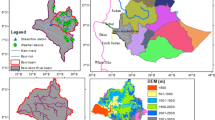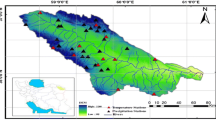Abstract
Climate change has substantial impacts on regional hydrology in the major river basins. To figure out such latent hydrological impacts of changing climate, more reliable hydrological simulations are imperative. In this study, we evaluated the impacts of climate change on hydrological regime in the Upper Yangtze River Basin based on four downscaled and bias-corrected Global Climate Model outputs from Coupled Model Intercomparison Project Phase 5 under four Representative Concentration Pathways (RCP2.6, RCP4.5, RCP6.0, and RCP8.5) driving three hydrological models. Two model evaluation approaches were applied: simple and comprehensive. The comprehensive approach was used to evaluate models in the historical period, optimizing objective function at four gauges, and hydrological models were weighted for impact assessment based on their performance. In such a way, projected streamflow time series are obtained under different emission scenarios. Results show that the annual average discharge is projected to increase by 4.1–10.5% under the RCP scenarios at the end of twenty-first century relative to the reference period (1970–1999). Moreover, the high flow is projected to increase and the low flow to decrease indicating a higher probability of flood and drought occurrence in the basin. The severity of floods and droughts may increase. In comparison with the simple one-site model evaluation approach, the comprehensive method reveals that the anticipated extreme flow events would be less severe, and annual mean discharge slightly lower. The projected results imply that application of the comprehensive model evaluation approach could narrow the simulated spreads of projections significantly, and might provide more credible results.




Similar content being viewed by others
References
Abbaspour KC et al (2004) Estimating uncertain flow and transport parameters using a sequential uncertainty fitting procedure. Vadose Zone J 3:1340–1352
Arnold JG et al (1998) Large area hydrologic modeling and assessment part I: model development. JAWRA J Am Water Resour Assoc 34:73–89
Arsenault R et al (2015) A comparative analysis of 9 multi-model averaging approaches in hydrological continuous streamflow simulation. J Hydrol 529:754–767
Bartholomé E, Belward AS (2005) GLC2000: a new approach to global land cover mapping from Earth observation data. Int J Remote Sens 26:1959–1977
Beaulieu E et al (2012) High sensitivity of the continental-weathering carbon dioxide sink to future climate change. Nat Clim Chang 2:346
Bastola S et al (2011) The role of hydrological modelling uncertainties in climate change impact assessments of Irish river catchments. Adv Water Resour 34:562–576
Bergström S, Forsman A (1973) Development of a conceptual deterministic rainfall-runoff mode. Nord Hydrol 4:240–253
Beven K (1996) The limits of splitting: hydrology. Sci Total Environ 183:89–97
Bosshard T et al (2013) Quantifying uncertainty sources in an ensemble of hydrological climate-impact projections. Water Resour Res 49:1523–1536
Braud I et al (2010) The use of distributed hydrological models for the Gard 2002 flash flood event: analysis of associated hydrological processes. J Hydrol 394:162–181
Chai Y et al (2019) Influence of climate variability and reservoir operation on streamflow in the Yangtze River. Sci Rep 9:1–10
Chen J et al (2014) Variability and trend in the hydrology of the Yangtze River, China: annual precipitation and runoff. J Hydrol 513:403–412
Chiang LC et al (2014) Assessing SWAT’s performance in the Kaskaskia River watershed as influenced by the number of calibration stations used. Hydrol Process 28:676–687
Chu PH et al (2019) Prospects of hydropower industry in the Yangtze River Basin: China’s green energy choice. Renew Energy 131:1168–1185
Cloke HL, Pappenberger F (2009) Ensemble flood forecasting: a review. J Hydrol 375:613–626
Eghdamirad S et al (2019) The influence of dependence in characterizing multi-variable uncertainty for climate change impact assessments. Hydrol Sci J 64:731–738
Ejder T et al (2016) Effects of climate change on annual streamflow of Kocabaş Stream (Çanakkale, Turkey). J Scient Res Rep 11:1–11
Fang YH et al (2017) Study of the spatiotemporal characteristics of meltwater contribution to the total runoff in the upper Changjiang River basin. Water 9:165
FAO/IIASA/ISRIC/ISS-CAS/JRC (2009) Harmonized world soil database (version 1.1. FAO: IIASA, Rome: Laxenburg
Franco ACL, Bonumá NB (2017) Multi-variable SWAT model calibration with remotely sensed evapotranspiration and observed flow. RBRH, 22
Frieler K et al (2017) Assessing the impacts of 1.5°C global warming–simulation protocol of the Inter-Sectoral Impact Model Intercomparison Project (ISIMIP2b). Geosci Model Dev 10:4321–4345
Gao C et al (2020) A 439-year simulated daily discharge dataset (1861-2299) for the upper Yangtze River. China. Earth Syst Sci Data 12:387–402
Gosling SN et al (2017) A comparison of changes in river runoff from multiple global and catchment-scale hydrological models under global warming scenarios of 1°C, 2°C and 3°C. Clim Chang 141:577–595
Guan Y et al (2015) Trends and variability of daily temperature extremes during 1960–2012 in the Yangtze River Basin, China. Glob Planet Chang 124:79–94
Hattermann FF et al (2017) Cross-scale intercomparison of climate change impacts simulated by regional and global hydrological models in eleven large river basins. Clim Chang 141:561–576
Hempel S et al (2013) A trend-preserving bias correction–the ISI-MIP approach. Earth Syst Dynam 4:219–236
Hipel KW, McLeod AI (1994) Time series modelling of water resources and environmental systems, vol 45. Elsevier, Amsterdam
hoc AG-Boden (2006) Bodenkundliche Kartieranleitung, 5. Verbesserte und erweiterte Auflage, Bundesanstalt für Geowissenschaften und Rohstoffe, Stuttgart
Huang SC et al (2017) Evaluation of an ensemble of regional hydrological models in 12 large-scale river basins worldwide. Clim Chang 141:381–397
IPCC (2013) Climate change 2013: the physical basis. In: Contribution of working group to the fifth assessment report of the IPCC. Cambridge University Press, New York
Jarvis A et al (2008) Hole-filled seamless SRTM data V4, International Centre for Tropical Agriculture (CIAT), available at: http://srtm.csi.cgiar.org.
Jones PW (1999) First-and second-order conservative remapping schemes for grids in spherical coordinates. Mon Weather Rev 127:2204–2210
Kendall MG (1975) Rank correlation methods. Griffin, London
Knutti R, Sedlácek J (2013) Robustness and uncertainties in the new CMIP5 climate model projections. Nat Clim Chang 3:369–373
Krysanova V et al (1999) Modelling river discharge for large drainage basins: from lumped to distributed approach. Hydrol Sci J 44:313–331
Krysanova V et al (2018) How the performance of hydrological models relates to credibility of projections under climate change. Hydrol Sci J 63:696–672
Krysanova V, Hattermann FF (2017) Intercomparison of climate change impacts in 12 large river basins: overview of methods and summary of results. Clim Chang 141:363–379
Krysanova V et al (2016) Assessment of climate change impacts on water resources. In: Handbook of Applied Hydrology, p 1440
Kundzewicz ZW et al (2018) Uncertainty in climate change impacts on water resources. Environ Sci Pol 79:1–8
Lange S (2018) Bias correction of surface downwelling longwave and shortwave radiation for the EWEMBI dataset. Earth Syst Dynam 9:627–645
Liang X et al (1994) A simple hydrologically based model of land surface water and energy fluxes for general circulation models. J Geophys Res - Atmos 99:14415–14428
Liu LL, Du JJ (2017) Documented changes in annual runoff and attribution since the 1950s within selected rivers in China. Adv Clim Chang Res 8:37–47
Liu SY et al (2009) Estimation of glacier runoff and future trends in the Yangtze River source region, China. J Glaciol 55:353–362
Martens B et al (2016) Improving terrestrial evaporation estimates over continental Australia through assimilation of SMOS soil moisture. Int J Appl Earth Obs 48:6–162
Mann HB (1945) Nonparametric tests against trend. Econometrica 13:245–259
Miralles DG et al (2011) Global land-surface evaporation estimated from satellite-based observations. Hydrol Earth Syst Sci 15:53–469
Miralles DG et al (2014) Mega-heatwave temperatures due to combined soil desiccation and atmospheric heat accumulation. Nat Geosci 7:45–349
Moriasi DN et al (2015) Hydrologic and water quality models: performance measures and evaluation criteria. Trans ASABE 58:163–1785
Motavita DF et al (2019) The comprehensive differential split-sample test: a stress-test for hydrological model robustness under climate variability. J Hydrol 573:501–515
National Bureau of Statistics (2011) China statistical yearbook 2011. National Bureau of Statistics, China Statistics Press, Beijing (in Chinese)
Puertes C et al (2019) Explaining the hydrological behaviour of facultative phreatophytes using a multi-variable and multi-objective modelling approach. J Hydrol 575:395–407
Qi J et al (2019) Coupled snow and frozen ground physics improves cold region hydrological simulations: an evaluation at the Upper Yangtze River Basin (Tibetan Plateau). J Geophys Res-Atmos 124:12985–13004
Ren ZH et al (2010) Quality control procedures for hourly precipitation data from automatic weather stations in China. Meteorol Month 36:123–132 (in Chinese)
Sen PK (1968) Estimates of the regression coefficient based on Kendall’s tau. J Am Stat Assoc 63:1379–1389
Shamseldin AY et al (2007) A comparative study of three neural network forecast combination methods for simulated river flows of different rainfall—runoff models. Hydrol Sci J 52:896–916
Shi Y et al (2005) A concise China glacier inventory. Shanghai Science Popularization Press, Shanghai (in Chinese)
Su BD et al (2017) Impacts of climate change on streamflow in the upper Yangtze River basin. Clim Chang 141:533–546
Sun J et al (2013) Hydrological impacts of climate change in the upper reaches of the Yangtze River Basin. Quat Int 304:62–74
Sun QH et al (2018) A review of global precipitation data sets: data sources, estimation, and intercomparisons. Rev Geophys 56:79–107
Taylor KE et al (2012) An overview of CMIP5 and the experiment design. B AM Meteorol Soc 93:485–498
Teng J et al (2012) Estimating the relative uncertainties sourced from GCMs and hydrological models in modeling climate change impact on runoff. J Hydrometeorol 13:122–139
Tomer MD, Schilling KE (2009) A simple approach to distinguish land-use and climate-change effects on watershed hydrology. J Hydrol 376:24–33
Uyanık GK, Güler N (2013) A study on multiple linear regression analysis. Procedia Soc Behav Sci 106:234–240
Vetter T et al (2015) Multi-model climate impact assessment and intercomparison for three large-scale river basins on three continents. Earth Syst Dynam 6:17–43
Vetter T et al (2017) Evaluation of sources of uncertainty in projected hydrological changes under climate change in 12 large-scale river basins. Clim Chang 141:419–433
Wang W et al (2019) Attribution of decreasing annual and autumn inflows to the Three Gorges Reservoir, Yangtze River: climate variability, water consumption or upstream reservoir operation? J Hydrodyn 579:124180
Wang X et al (2017) Effects of permafrost degradation on the hydrological regime in the source regions of the Yangtze and Yellow Rivers, China. Water 9:897
Warszawski L et al (2014) The inter-sectoral impact model intercomparison project (ISI–MIP): project framework. Proc Natl Acad Sci U S A 111:3228–3232
Wu J, Gao X (2013) A gridded daily observation dataset over China region and comparison with the other datasets. Chin J Geophys 56:1102–1111
Zaherpour J et al (2018) Worldwide evaluation of mean and extreme runoff from six global-scale hydrological models that account for human impacts. Environ Res Lett 13:065015
Zhao C et al (2015) Validation of the accuracy of different precipitation datasets over Tianshan mountainous area. Adv Meteorol 2015
Acknowledgments
The authors would like to thank the ISIMIP modeling group for providing the climate data and methodological guidance.
Funding
This study was jointly supported by the National Key Research and Development Program of China (2017YFA0603701), the National Natural Science Foundation of China (42005126), China Postdoctoral Science Foundation funded project (2020M671536), Jiangsu Planned Projects for Postdoctoral Research Funds (2019K096), and High-level Talent Recruitment Program of the Nanjing University of Information Science and Technology (NUIST).
Author information
Authors and Affiliations
Corresponding authors
Additional information
Publisher’s note
Springer Nature remains neutral with regard to jurisdictional claims in published maps and institutional affiliations.
This article is part of a Special Issue on “How evaluation of hydrological models influences results of climate impact assessment", edited by Valentina Krysanova, Fred Hattermann, and Zbigniew Kundzewicz
Shanshan Wen and Buda Su are first authors
Supplementary information
ESM 1
(DOCX 2981 kb)
Rights and permissions
About this article
Cite this article
Wen, S., Su, B., Wang, Y. et al. Comprehensive evaluation of hydrological models for climate change impact assessment in the Upper Yangtze River Basin, China. Climatic Change 163, 1207–1226 (2020). https://doi.org/10.1007/s10584-020-02929-6
Received:
Accepted:
Published:
Issue Date:
DOI: https://doi.org/10.1007/s10584-020-02929-6




